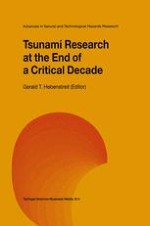2001 | OriginalPaper | Chapter
Numerical Study of the Source of the July 17, 1998 PNG Tsunami
Authors : Vasily Titov, Frank González
Published in: Tsunami Research at the End of a Critical Decade
Publisher: Springer Netherlands
Included in: Professional Book Archive
Activate our intelligent search to find suitable subject content or patents.
Select sections of text to find matching patents with Artificial Intelligence. powered by
Select sections of text to find additional relevant content using AI-assisted search. powered by
The relatively small July 17, 1998 Papua New Guinea earthquake produced very high tsunami amplitudes, localized along a short length of coast near the earthquake source. This prompted speculation regarding possible tsunami source scenarios, including seismic bottom deformation, submarine and/or subaerial slumping, or combinations of each. The MOST numerical model was used to simulate scenarios in which the source was assumed to be either co-seismic bottom deformation or a submarine landslide, modeled as viscous sediment flow. Sources of various sizes at different locations were assumed, and the computed runup estimates were compared with measurements obtained by the International Tsunami Survey Team (ITST). Although distinctions in the tsunami runup dynamics for different tsunami sources are apparent, it was found that both pure landslide and pure bottom deformation scenarios could produce results that satisfactorily matched the observed runup heights. Thus, in the case of the PNG tsunami, and probably many other events as well, runup values alone are insufficient to distinguish between co-seismic, landslide, or combined source mechanisms. Additional information, such as current velocities, sediment deposition and scouring, number of waves and direct measurements in the source area, are necessary for accurate tsunami source determination.
